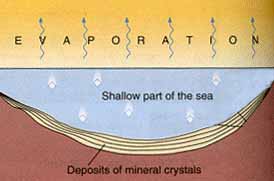 FORMATION |
 PROPERTIES |
 PROFILES |
 GUESTBOOK |
 |
||
![]()
SEDIMENTARY ROCKS FORMATION
Sedimentary rocks are formed in two ways. Some are formed by pressing together or compacting loose particles which have been deposited on land or in water bodies such as seas or lakes. These loose particles are called sediments. Other sedimentary rocks are formed by the crystallisation of dissolved minerals.
Fig 1: Compaction of sedimentsSediments may be rock particles such as mud, sand or pebbles which are usually deposited in the sea by rivers and waves. They can also be remains of living things such as plants and animals. Gradually, over thousands or even millions of years, these sediments accumulate layer by layer, forming thick deposits on land or on the sea foor (SEE Fig 1). The weight of the overlying sediments will compact those found below. Over time, the compacted sediments become sedimentary rocks. Sometimes, these sedimentary rocks may be uplifted as a result of plate movements forming mountain, eg. The Himalayas.
BY CRYSTALLISATION FROM DISSOLVED MINERALS
Fig 2: Crystallisation of dissolved minerals in a shallow part of the sea.The process of forming crystals from dissolved minerals usually occurs in the shallow parts of the sea or in lakes in desert areas where evaporation is much higher than precipitation. The sea or lake contains dissolved minerals such as calcium bicarbonate and calcium sulphate. As evaporation takes place, water is lost and the dissolved minerals from crystals which settle on the bottom of the sea of lake (SEE Fig 2). As evaporation continues, more crystals from and accumulate on the sea or lake floor, becoming sedimentary rocks.
![]()
 FORMATION |
 PROPERTIES |
 PROFILES |
 GUESTBOOK |
 |
||
© Copyright 1997 Stupid Page Series. All graphics and pages created and maintained by Qin.

